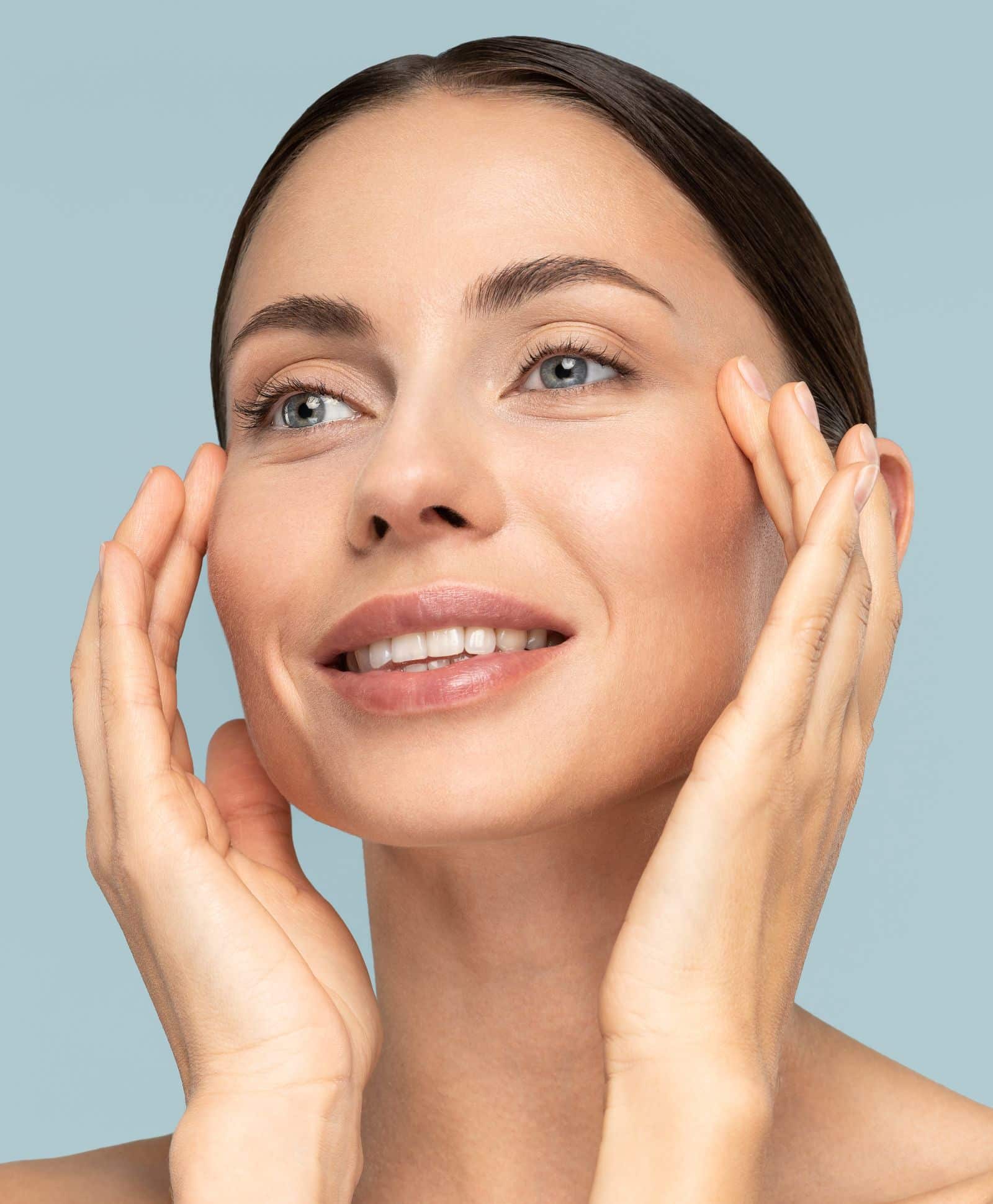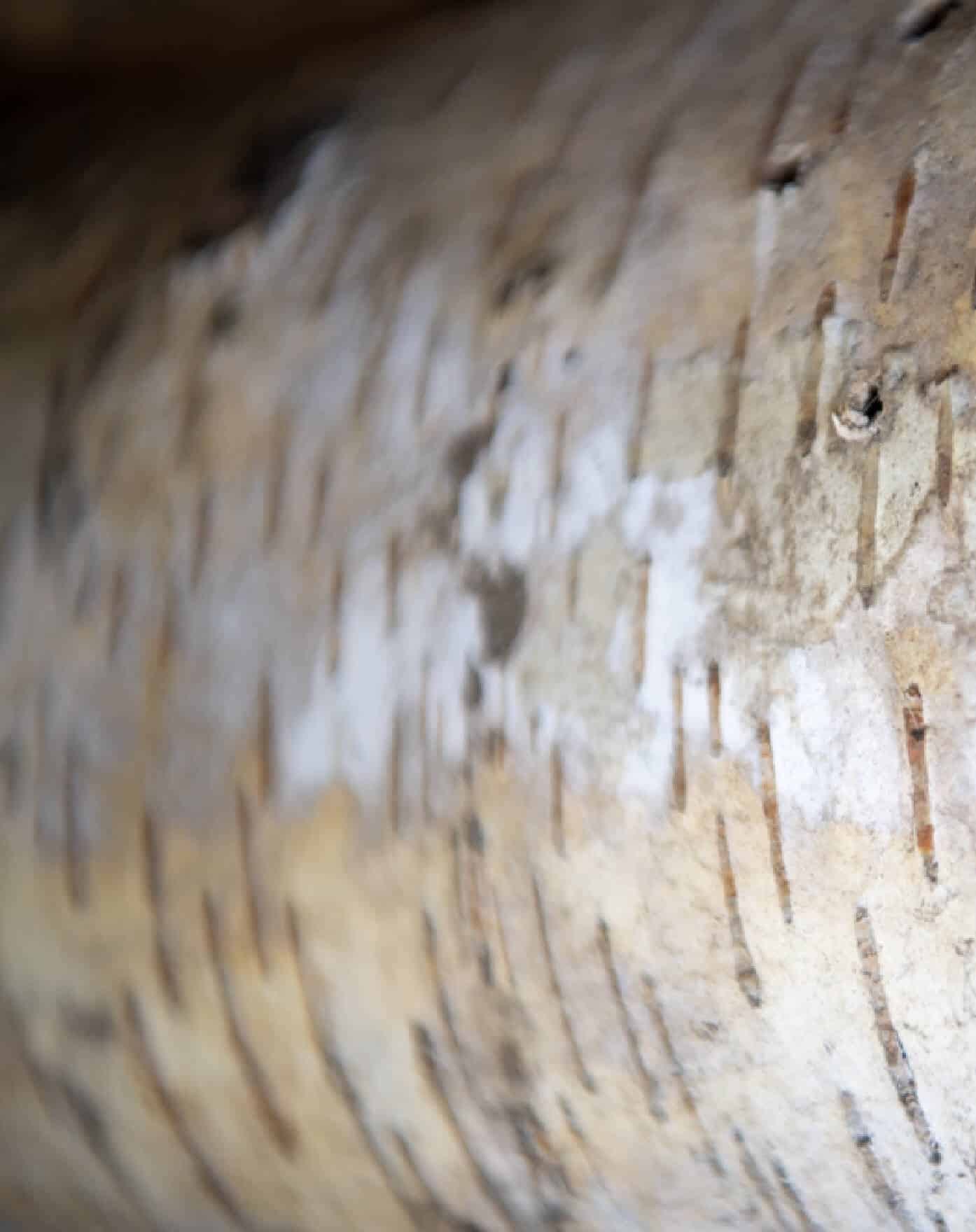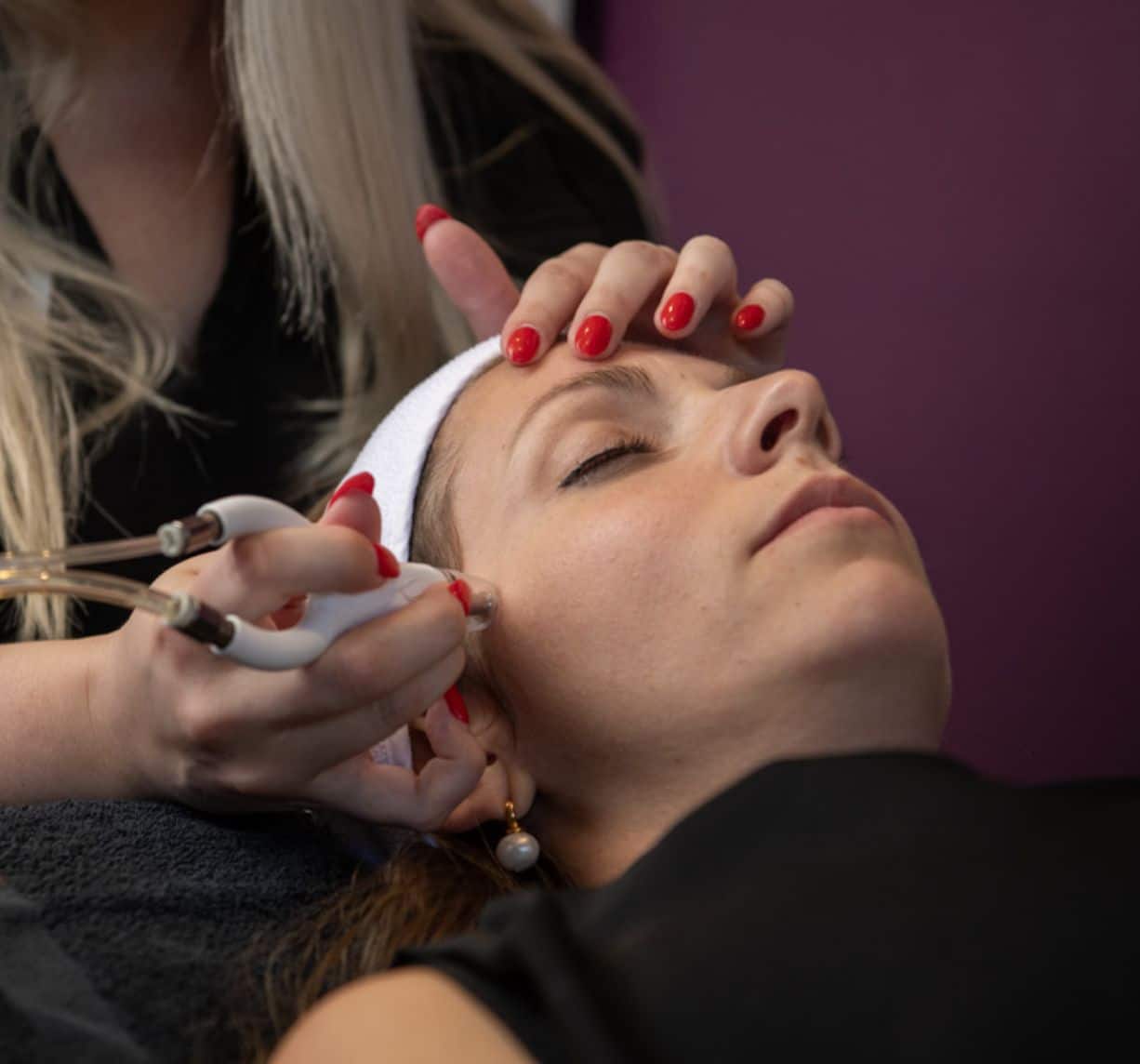Chemical Peels in Eugene, OR
For patients who are unhappy with the texture or tone of their facial skin, chemical peels can be an effective option to restore the natural smoothness and vitality to your complexion that may be marred by wrinkles, blemishes, sun damage, or uneven pigmentation.
The team of medical professionals at Aesthetic Plastic Surgery is known for outstanding patient care and personalized procedures. Our Certified Advanced Estheticians take the time to understand your needs so that you feel confident and comfortable in your decision to move forward with non-surgical rejuvenation.
If you’d like to learn more about whether our chemical peel treatment is right for you, please call our office in Eugene today for more details. We offer free consultations for our medical spa patients.
Rediscover the radiance beneath the surface with our expert-guided chemical peels, designed to bring out the best in your skin while ensuring a safe and soothing experience.

 Model
Model
“The staff that manages and performs the “spa” side of the office is efficient and professional while being good humored. Thank you for your service! It was fun to go back and read some of these reviews just now. I always like their advice and was very impressed that Dr Baldwin texted me after a past service and asked how I liked the results!”

Before Your Chemical Peel
Prior to your chemical peel, you’ll sit down with one of our Certified Advanced Estheticians, who can discuss your options with you. Depending on your skin type and how extensive you’d like your results to be, our Certified Advanced Esthetician will determine which chemical peel will provide you with the best benefits for your goals. Certain peels may not be suitable for some skin types, so your consultation is an essential step in making sure you receive the best care possible.
The best candidates for a chemical peel are men or women who struggle with uneven pigmentation, rough skin texture, facial blemishes, or scars. Your Certified Advanced Esthetician may recommend that you treat your skin with Retin-A or special cleansing solutions for several weeks before your treatment. Proper skin therapy before your peel can improve the appearance of your results and reduce healing time. Sometimes, chemical peels are combined with facials or dermaplaning for even better results.
What is a Chemical Peel?
A chemical peel refreshes and improves the skin’s appearance. Applying a specialized solution to the skin’s surface exfoliates the outer layers, revealing new, untouched skin. This process helps reduce fine lines, wrinkles, uneven skin tone, excess oil, clogged pores, and acne. The result is a noticeable improvement in skin tone and texture, giving you smooth and vibrant skin with a youthful glow.
How Do Chemical Peels Work?
A chemical peel, or chemexfoliation, uses a chemical solution to enhance the skin’s appearance. Applying the solution to the epidermis causes controlled damage that separates damaged and healthy skin, allowing for exfoliation and dead cell removal. This process boosts collagen production, improving skin tone and texture. Post-peeling, your skin becomes smoother, brighter, and less lined or wrinkled. The main benefits of chemical peels include reduced acne and scarring, diminished hyperpigmentation, enhanced effectiveness of skincare products, and fewer signs of aging. They work by unclogging pores, breaking down clogged follicles, and killing bacteria, which prevents future acne. Additionally, they help skincare products penetrate deeper and stimulate new collagen and elastin production, reducing fine lines and wrinkles.
Chemical Peels vs. Other Treatments
Chemical peels are a standout option in skin rejuvenation, utilizing specific chemical solutions to remove the outermost skin layer and reveal a fresher, more radiant layer underneath. This sets them apart from traditional facials, which mainly focus on cleansing pores, extracting impurities like blackheads, and hydrating the skin with serums. Chemical peels offer deeper exfoliation, significantly renewing the skin’s appearance.
In comparison, microdermabrasion employs mechanical exfoliation using a diamond-tipped device or fine crystals to remove dead skin cells, generally providing a milder treatment than chemical peels. Chemical peels can be customized in strength, ranging from gentle to robust, to address fine lines, acne, hyperpigmentation, and uneven texture.
By accelerating cell turnover, chemical peels rejuvenate the skin’s surface and stimulate its natural healing process, resulting in smoother, clearer, and more youthful-looking skin.
Benefits of a Chemical Peel Treatment
Benefits of a Chemical Peel
- Corrects Sun Damage: Effectively repairs and diminishes the signs of sun-damaged skin.
- Reduces Fine Lines and Wrinkles: Smooths out fine lines and wrinkles, revealing smoother skin.
- Removes Hyperpigmentation: Helps to even out skin tone by reducing dark spots and hyperpigmentation.
- Aids in Acne and Acne Scars: Improves the appearance of acne and reduces the visibility of acne scars.
- Exfoliates Surface Skin Layer: Removes the outermost layer of dead skin cells, unveiling rejuvenated and youthful skin.
- Minimizes Dullness: Enhances skin brightness and reduces dullness for a more vibrant complexion.
- Reduces Scarring: Significantly lessens the appearance of scars for smoother skin texture.
- Assists with Skin Disorders: May help in managing skin conditions like acne and rosacea.
- Maintains Radiant Complexion: This keeps your skin looking radiant and healthy.
- Stimulates Collagen Production: Encourages collagen production, promoting the growth of new skin cells for long-term benefits.
Your Chemical Peel Procedure
A chemical peel uses unique plant and sugar acids to penetrate and remove dead skin cells, revealing the fresh layer of skin underneath and helping to even out your complexion. Chemical peels differ by which acids are used and how deeply they penetrate to exfoliate the skin. Depending on your physical assessment during your consultation, our Certified Advanced Estheticians will recommend one of several types of skin peels:
Basic Lactic Acid Peels
The gentlest peel offered, a lactic acid peel, uses acids derived from milk and is an ideal treatment for sensitive or mature skin. It assists in boosting hydration levels along with improving the texture and tone of the skin to smooth out wrinkles and help fade blemishes. Depending on the pigmentation in your face, this peel may lighten the tone of your skin as well.
Glycolic Peels
Glycolic peels utilize water-soluble acids derived from sugar that penetrate the skin more deeply than lactic acid peels. This treatment may be accompanied by mild burning or tingling sensations while the acids remove damaged skin cells from the skin’s surface. Glycolic acid treatments are appropriate for most skin types and are particularly effective in addressing fine wrinkles, pigmented spots, and other signs of aging.
Salicylic Acid Peels
A peel that uses oil-soluble acids derived from birch bark, willow bark and wintergreen leaves, this treatment is particularly effective at addressing acne-causing oils trapped beneath the skin. Sun-damaged skin may also benefit from this treatment.
TCA Peels
The TCA peel is specifically designed to exfoliate damaged skin and promote deep skin rejuvenation by penetrating the papillary dermis. This peel is formulated to treat stubborn pigmentation that surface-level peels may not be able to effectively address.
 Model
Model
Healing Process for Your Chemical Peel
Your recovery time will depend on what type of peel you had, how much of your face was treated, and your skin type. Good skin care is an important part of the healing process and can minimize your recovery time as well as optimize your results.
Your skin will likely be very sensitive after your peel, and managing your care is important to the outcome of your recovery. Washing your face often with water or other approved cleansing solutions, as well as using a daily moisturizer, can keep your skin clean, hydrated, and free from dust and oil.
If you had a deep peel performed, you may have to use ointment over the treated area for several days. You should continue to avoid unprotected sun exposure after your skin has stopped peeling, as new skin is thinner and at greater risk for sun damage.
Before, During, and After
What To Expect Before a Chemical Peel Treatment
Before undergoing a chemical peel at Aesthetic Plastic Surgery, the first step is to schedule a consultation with one of our experienced specialists. During this session, our Certified Advanced Aestheticians will evaluate your skin, discuss your specific needs, and guide you in choosing the most suitable treatment to achieve your desired results. Based on your individual goals and skin concerns, we will recommend the most effective chemical peel to help you reach your aesthetic objectives.
Before undergoing a chemical peel, the first step is to schedule a consultation with one of our specialists at Aesthetic Plastic Surgery. During this session, our Certified Advanced Aestheticians will evaluate your skin, discuss your concerns, and help you identify the best approach to achieve your desired results. Based on your specific needs and aesthetic goals, we’ll recommend the most suitable chemical peel to optimize your skin’s appearance.
In Eugene, our team of skilled aestheticians is dedicated to helping you achieve radiant, healthy skin. We offer personalized chemical peels designed to cater to various skin types. Before your treatment, one of our expert skin care specialists will guide you through the process, ensuring you find the perfect peel for your unique needs.
What To Expect During a Chemical Peel Treatment
A chemical peel starts with an aesthetician cleansing your face and applying a chemical solution to it. The sensations you feel can vary from mild stinging to burning, depending on the depth of the peel. Light peels typically cause slight discomfort and require minimal downtime. Medium peels may result in redness, a whitish-grey skin appearance, and flaking like a sunburn, recovery starting within 48 hours. Deep peels involve more preparation, including the use of sedatives and anesthetics, and result in redness, swelling, and peeling that can last several weeks. However, they offer dramatic, long-lasting results that can persist for up to 10 years.
What To Expect After a Chemical Peel Treatment
After a chemical peel, the skin may react differently depending on the peel’s intensity. For light peels, you might experience mild redness, stinging, and some flaking, but your skin color won’t change. It’s crucial to avoid direct sunlight and use sunscreen after treatment. Medium peels often result in more noticeable redness and flaking, like a severe sunburn. With deep peels, expect about a two-week recovery period before resuming normal activities and be prepared for peeling, crusting, and redness that can last up to three months. Discomfort is typically managed with prescribed pain relief. Despite these temporary side effects, the long-lasting benefits of a deep peel can be impressive, with results lasting up to ten years.
More Information about Chemical Peels
To start exploring your options for a chemical peel in Eugene, contact our office and schedule a consultation with a member of our team.
Frequently asked questions
What skin conditions can be treated with chemical peels?
A chemical peel treats various skin concerns, including hyperpigmentation, melasma, blemishes, acne scars, fine lines, uneven skin tone, rough texture, dry patches, certain types of scarring, and sun-damaged skin. These treatments are effective for maintaining a radiant and youthful complexion.
What types of chemical peels are available?
We offer a variety of chemical peels in Eugene to cater to different skin types and concerns. Our lactic acid peels are gentle yet effective, ideal for sensitive skin and first-time users. They help to hydrate the skin while exfoliating dead cells, resulting in a brighter complexion. Glycolic acid peels are more potent and penetrate deeper into the skin, making them suitable for treating fine lines, acne scars, and hyperpigmentation. Salicylic acid peels are perfect for those struggling with acne and oily skin, as they effectively unclog pores and reduce inflammation. Lastly, our TCA (Trichloroacetic) peels are the most intensive, offering significant improvement for severe sun damage, deep wrinkles, and scarring. Each is designed to rejuvenate your skin, providing a smoother, clearer, and more radiant complexion.
Who is a good candidate for a chemical peel?
If you have wrinkles, acne scars, uneven skin tone, hyperpigmentation, or post-acne marks you are an ideal candidate for a chemical peel. Individuals with recurring breakouts and visible skin discoloration can benefit from this treatment.
How long do the results of a chemical peel last?
Typically, a chemical peel lasts from 2-6 months to years, depending on the type of peel and how well you care for your skin. Sun protection is crucial to maintain enhancements.
Are there any side effects or risks associated with chemical peels?
You might notice irritation, skin peeling, and mild burning feeling after a chemical peel. These side effects are usually temporary and should subside as your skin gets used to the treatment. In rare cases, you may also experience increased pigmentation.
Contact Us
We Would Love To Hear From You
